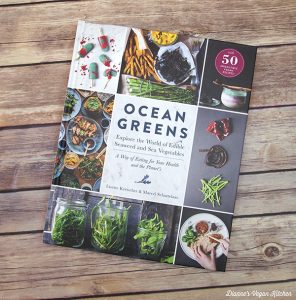 When I was younger, the idea of eating seaweed seemed less than appetizing. My dad was in the Air Force, and we were stationed in England for a few years. Rather than live in base housing, we rented a house in a small village on the beach, where you could often find large piles of seaweed mixed with bits of driftwood and small shells. It never looked very appetizing, and I wasn’t too crazy about the smell. As I grew older and went vegetarian, I began to experiment with new foods, though, I began to enjoy different varieties of seaweeds and sea vegetables in foods like vegetable sushi, miso soup, and even veggie burgers.
When I was younger, the idea of eating seaweed seemed less than appetizing. My dad was in the Air Force, and we were stationed in England for a few years. Rather than live in base housing, we rented a house in a small village on the beach, where you could often find large piles of seaweed mixed with bits of driftwood and small shells. It never looked very appetizing, and I wasn’t too crazy about the smell. As I grew older and went vegetarian, I began to experiment with new foods, though, I began to enjoy different varieties of seaweeds and sea vegetables in foods like vegetable sushi, miso soup, and even veggie burgers.
While studying to become a health coach, I learned a little bit about the health benefits of seaweed and sea vegetables, and I began to incorporate them into more of my meals. I wasn’t doing much more than sprinkling nori flakes to my salads or adding dulse to arame to stir-fries. So, I when I was offered a copy of Ocean Greens: Explore the World of Edible Seaweed and Sea Vegetables: A Way of Eating for Your Health and the Planet’s by Lisette Kreischer and Marcel Schuttelaar, I jumped at the opportunity. Not only did I want some creative recipes that use this superfood, I wanted to learn more about its health properties. Ocean Greens definitely delivered, and it even exceeded my expectations.
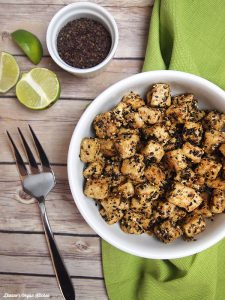 Ocean Greens is packed with information about seaweed, including what it is, where to find it, and how it’s harvested. The book explains why it’s so good for us, and why eating it can help save the planet. There’s a rundown on the different types of seaweeds and sea vegetables, and I was quite impressed with just how many varieties there are. There’s also a list of dos and don’ts, for those who are new to cooking with seaweed.
Ocean Greens is packed with information about seaweed, including what it is, where to find it, and how it’s harvested. The book explains why it’s so good for us, and why eating it can help save the planet. There’s a rundown on the different types of seaweeds and sea vegetables, and I was quite impressed with just how many varieties there are. There’s also a list of dos and don’ts, for those who are new to cooking with seaweed.
Ocean Greens also includes 50 vegan recipes that use seaweed and sea vegetables. These meals aren’t just sushi and soup – they’re highly creative dishes, from sauces and toppings, to hor d’oeuvers and salads. There are also plenty of main dishes and desserts. Yes, you make desserts with seaweed! The recipes are all accompanied by gorgeous, mouth-watering photos.
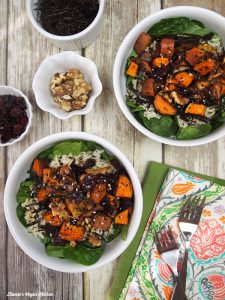 When the book arrived, I sat down and read it from cover to cover like a novel, and I found myself marking off so many recipes that I wanted to make. Creamy Baby Green Pesto Sauce? Yes, please! Pasta Carbonara with ‘Weed Sauce and Tempeh Bacon? Uh-huh! Just Another Tiramisu? Don’t mind if I do!
When the book arrived, I sat down and read it from cover to cover like a novel, and I found myself marking off so many recipes that I wanted to make. Creamy Baby Green Pesto Sauce? Yes, please! Pasta Carbonara with ‘Weed Sauce and Tempeh Bacon? Uh-huh! Just Another Tiramisu? Don’t mind if I do!
I happened to have some hajiki and a wild rice blend on hand, so I went with Autumnal Wild Rice Salad with Haijiki for my first dish. This was a delicious, meal-worthy salad that’s perfect for this time of year. I’m glad the recipe made four servings, because I wanted more! I also made Savory Seaweed Muffins, which paired perfectly with Sailors Butter. Both of these recipes use seaweed flakes, which I also happened to have on hand. I prefer savory muffins to the sweet variety, and these were perfect for afternoon snacking. Tofu with Seaweed Crunch looked too good to pass up, and it tasted just as good as it looked. I served it for dinner with veggies and rice, but it would be a perfect holiday appetizer, too.
If you want to learn about the nutritional benefits of sea vegetables and how to creatively incorporate them into your meals, Ocean Greens is the book for you!
- 1 cup (250 ml) oat or almond milk
- ¹/3 cup (100 ml) olive oil
- Zest and juice of ½ lemon
- 2 cups (250 g) whole grain spelt flour
- 1 tablespoon dried sea lettuce
- 1 tablespoon dulse flakes
- 1 tablespoon nutritional yeast
- 1½ teaspoons baking powder
- 1½ teaspoon dried thyme
- 1 teaspoon fine sea salt
- 1 teaspoon smoked paprika (pimenton)
- 6 sun-dried tomatoes in oil, sliced
- 2 scallions, sliced
- Toasted sesame seeds
- Preheat the oven to 375°F (190°C). Line a silicone muffin pan for at least eight muffins with paper muffin cups.
- Combine the milk, oil, and lemon juice in a bowl. Allow the mixture to rest for about 5 minutes (the milk will begin to clump up—that is what we want).
- Combine the flour, dulse, sea lettuce, nutritional yeast, baking powder, thyme, salt, smoked paprika, tomatoes, scallions, and lemon zest in a separate bowl. Mix thoroughly.
- Stir the liquids into the solids, and mix until any lumps have disappeared but not any longer. It is vital that the baking powder isn’t activated before it’s in the oven. If you stir too long, the baking powder will begin to work.
- Divide the batter among the muffin cups, top with toasted sesame seeds, and place in the oven. Bake the muffins for about 25 minutes, until golden.
- 1 cup + 1 tablespoon (250 g) vegetable-based margarine, such as Earth Balance Buttery Spread, at room temperature
- 2 tablespoons (10 g) persil de la mer or dried sea lettuce flakes
- Zest from ½small lemon
- 1 shallot, minced
- 1 garlic clove, minced
- Fine sea salt and freshly ground black pepper, to taste
- Combine the margarine, persil de la mer, lemon zest, shallot, and garlic in a blender and puree until combined. Season with a pinch of salt and pepper—taste carefully; this recipe is naturally very salty!
- Place the butter in a closed container in the fridge for at least one hour to set. Remove from the fridge 10 minutes before serving. The butter will keep for up to 3 weeks in the fridge, or 2 months in the freezer.
Review reprinted with permission from Dianne’s Vegan Kitchen.
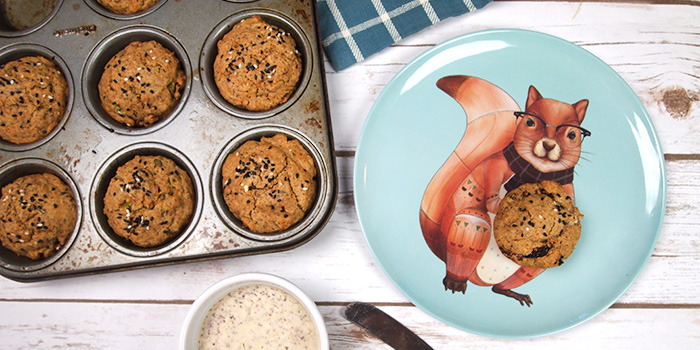
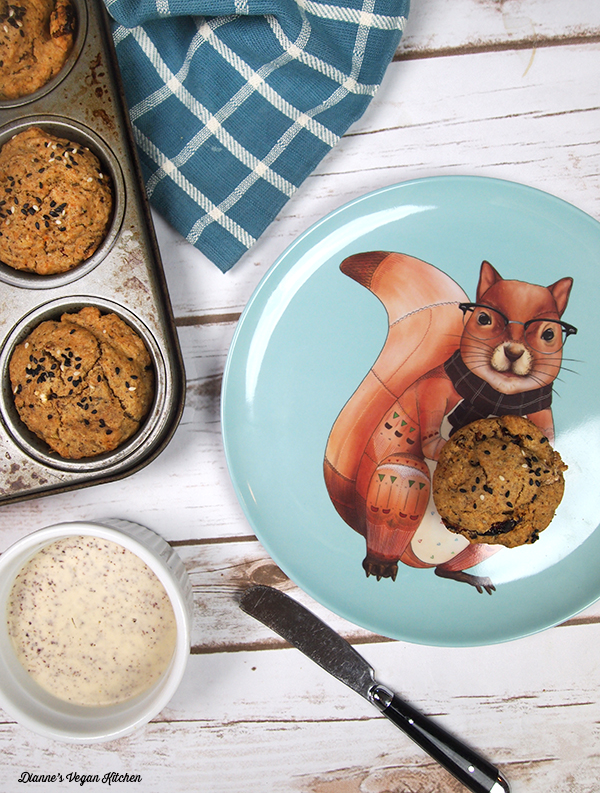
OMG, I love making savory muffins but have never added seaweed! That is genius. It adds such a great salty depth in flavor to things.
These are really good. I think you’ll like them, Alisa!